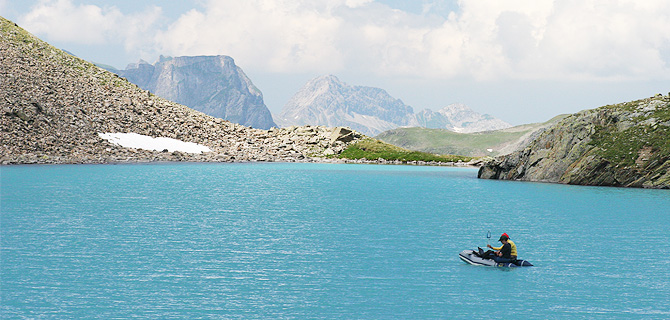Ciliate assemblages in six remote alpine lakes
(Faselfadseen, Austria)
Taxonomy, ecology and ultraviolet radiation protection strategies
In this study, for the first time, the ciliate assemblages of six alpine lakes, the Faselfadseen will be thoroughly investigated. The Faselfadseen are a group of remote lakes situated between 2,263 and 2,620 m above the sea level in the western Austrian Central Alps. They differ in altitude, transparency/turbidity and inflow and originate from the same glacier (‘Faselfadferner’). Although ciliates play an important role in the carbon cycling to higher tropic levels both in marine and freshwater ecosystems, knowledge on ciliate assemblages from alpine lakes and factors that lead to species-specific distributions in the water column are scarce. Alpine lakes are extreme habitats for water organisms because of low water temperatures, low food availability and high levels of incident solar radiation especially during the ice-free period.
The ciliate assemblages of the six Faselfadseen will be studied along vertical depth gradients. Their taxonomic composition will be analysed from morphology, phylogeny and biovolume observations. For cultivable species, also the biomass will be determined by CHN analysis. Further, alpine lakes show an increased transparency because of low chromophoric dissolved organic matter. Therefore, in such habitats, organisms are more exposed to high ultraviolet radiation (UVR, 290-400 nm) levels than in lowland lakes. To cope with elevated UVR levels in transparent lakes, organisms have developed different strategies like avoidance or protection mechanisms. In the Faselfadseen, the UV protection strategies of the ciliates such as the presence of mycosporine-like amino acids (MAAs) will be assessed. These colourless water soluble sunscreen compounds are widespread in marine and freshwater organisms and recently, their existence was proven in ciliates. Here, not only the presence but also their efficiency to accumulate MAAs from algal food and the UV-protective efficiency of MAAs if they are powerful sunscreen compounds will be experimentally tested in laboratory experiments.
Funded by the Austrian Academy of Sciences ÖAW (DOC-fForte program, ÖAW 22883), the FWF Austrian Science Fund (P21013-B03) and the Leopold-Franzens-University of Innsbruck (2012/3/BIO9).


